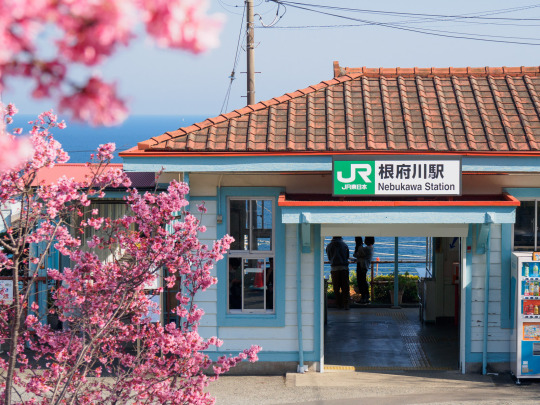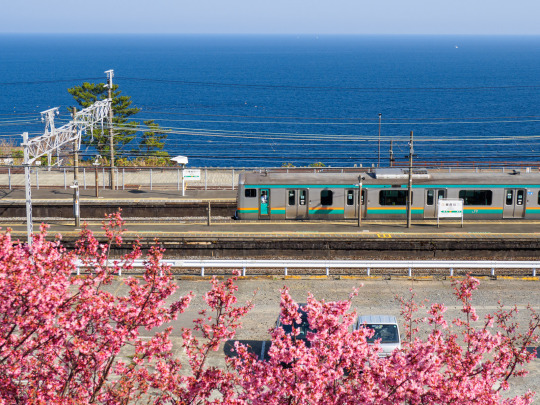#nebukawa
Text




Nebukawa Station, Kanagawa Prefecture by 海の見える駅
Visit this website to see more photos of seaside stations in Japan!
#nebukawa station#kanagawa prefecture#seaside stations#japan#train stations in japan#seaside stations in japan#trains in japan#japan countryside#rural japan#cherry blossoms#sakura#spring in japan
271 notes
·
View notes
Photo



普通列車でどこかへ #13
東海道本線 熱海行
神奈川県 根府川と湯河原のあたり
Amazon Japan Kindle 新井ワタルのページ
https://www.amazon.co.jp/新井ワタル/e/B0168GDX1M/
Go somewhere by local train #13
Tokaido Main Line bound for Atami
Around Nebukawa and Yugawara, Kanagawa
Amazon USA Kindle Watal Arai's Page
https://www.amazon.com/WATAL-ARAI/e/B01BODI7I8
13 notes
·
View notes
Photo

Great Kantō earthquake (1923) and the Massacres
The Great Kantō earthquake struck the Kantō Plain on the main Japanese island of Honshū at 11:58:44 JST (02:58:44 UTC) on Saturday, September 1, 1923. Varied accounts indicate the duration of the earthquake was between four and ten minutes. Extensive firestorms and even a fire whirl added to the death toll. The Kantō Massacre began on the day of the earthquake. The earthquake had a magnitude of 7.9 on the moment magnitude scale with its focus deep beneath Izu Ōshima Island in Sagami Bay. Estimated casualties totalled about 142,800 deaths, including about 40,000 who went missing and were presumed dead.
Because the earthquake struck when people were cooking meals, many were killed as a result of large fires that broke out. Fires started immediately after the earthquake. Some fires developed into firestorms that swept across cities. Many people died when their feet became stuck on melting tarmac. The single greatest loss of life was caused by a fire whirl that engulfed the Rikugun Honjo Hifukusho in downtown Tokyo, where about 38,000 people were incinerated after taking shelter there after the earthquake. The earthquake broke water mains all over the city, and putting out the fires took nearly two full days until late in the morning of September 3.
A strong typhoon centered off the coast of the Noto Peninsula in Ishikawa Prefecture brought high winds to Tokyo Bay at about the same time as the earthquake. These winds caused fires to spread rapidly.
Many homes were buried or swept away by landslides in the mountainous and hilly coastal areas in western Kanagawa Prefecture; about 800 people died. A collapsing mountainside in the village of Nebukawa, west of Odawara, pushed the entire village and a passenger train carrying over 100 passengers, along with the railway station, into the sea.
The RMS Empress of Australia was about to leave Yokohama harbor when the earthquake struck. It narrowly survived and assisted in rescuing 2000 survivors. A P&O liner, Dongola, was also in the harbor at the moment of disaster and rescued 505 people, taking them to Kobe.
A tsunami with waves up to 10 m (33 ft) high struck the coast of Sagami Bay, Bōsō Peninsula, Izu Islands, and the east coast of Izu Peninsula within minutes. The tsunami caused many deaths, including about 100 people along Yui-ga-hama Beach in Kamakura and an estimated 50 people on the Enoshima causeway. Over 570,000 homes were destroyed, leaving an estimated 1.9 million homeless. Evacuees were transported by ship from Kantō to as far as Kobe in Kansai. The damage is estimated to have exceeded US$1 billion (or about $16 billion today). There were 57 aftershocks.
Ethnic Koreans were massacred after the earthquake. The Home Ministry declared martial law and ordered all sectional police chiefs to make maintenance of order and security a top priority. A false rumor was spread that Koreans were taking advantage of the disaster, committing arson and robbery, and were in possession of bombs. Anti-Korean sentiment was heightened by fear of the Korean independence movement.
In the confusion after the quake, mass murder of Koreans by mobs occurred in urban Tokyo and Yokohama, fuelled by rumors of rebellion and sabotage. The government reported that 231 Koreans were killed by mobs in Tokyo and Yokohama in the first week of September. Independent reports said the number of dead was far higher, ranging from 6,000 to 10,000. Some newspapers reported the rumors as fact, including the allegation that Koreans were poisoning wells. The numerous fires and cloudy well water, a little-known effect of a large quake, all seemed to confirm the rumors of the panic-stricken survivors who were living amidst the rubble. Vigilante groups set up roadblocks in cities, and tested civilians with a shibboleth for supposedly Korean-accented Japanese: deporting, beating, or killing those who failed. Army and police personnel colluded in the vigilante killings in some areas. Of the 3,000 Koreans taken into custody at the Army Cavalry Regiment base in Narashino, Chiba Prefecture, 10% were killed at the base, or after being released into nearby villages. Moreover, anyone mistakenly identified as Korean, such as Chinese, Ryukyuans, and Japanese speakers of some regional dialects, suffered the same fate. About 700 Chinese, mostly from Wenzhou, were killed. A monument commemorating this was built in 1993 in Wenzhou.
In response, the government called upon the Japanese Army and the police to protect Koreans; 23,715 Koreans were placed in protective custody across Japan, 12,000 in Tokyo alone. The chief of police of Tsurumi (or Kawasaki by some accounts) is reported to have publicly drunk the well water to disprove the rumor that Koreans had been poisoning wells. In some towns, even police stations into which Korean people had escaped were attacked by mobs, whereas in other neighborhoods, civilians took steps to protect them. The Army distributed flyers denying the rumor and warning residents against attacking Koreans, but in many cases, vigilante activity only ceased as a result of Army operations against it. In several documented cases, soldiers and policemen participated in the killings, and in other cases, authorities handed groups of Koreans over to local vigilantes, who proceeded to kill them.
12 notes
·
View notes
Text

An edit I made of Lisa, Callie, and Arumen at Nebukawa Station.
I've always found these liminal spaces to be quite pleasant to look at, and it made me wonder what it'd be like if my characters were there, so I decided to draw some of them in.
0 notes
Photo

Evangelion1933+1931: Classroom Jumble
#evangelion#evangelion 3.0+1.0#shinji#Gendo#eva01#eva13#rebuild#anime#Cuphead#Disney#Popeye#1930#Evangelion Rebuild#nebukawa
77 notes
·
View notes
Photo

江の浦までプチトリップ🚙 . . 目指すは金目鯛のしゃぶしゃぶ😋 . . どんより曇り空も晴れて青空☀️ . . 帰りはサンセットに見送られながら✨ . . 〆は焼鳥😆 . . 楽しい大人の遠足でした💕 . . #根府川 #江の浦漁港 #磯料理 #一吉 @k.o.s.a.k.i.0.1.0.6 #最高 #美味 #お刺身盛り #金目鯛 #金目鯛のしゃぶしゃぶ #隠れ家 #海女小屋 #おもてなし #プチトリップ #大人の遠足 #seafoodrestaurant #nebukawa #enoura #ichiyoshi #kinmedai #sashimi #delicious #yummy (at 磯料理 一吉丸) https://www.instagram.com/p/CF15ctPDgK8/?igshid=1h85bk0fuitao
#根府川#江の浦漁港#磯料理#一吉#最高#美味#お刺身盛り#金目鯛#金目鯛のしゃぶしゃぶ#隠れ家#海女小屋#おもてなし#プチトリップ#大人の遠足#seafoodrestaurant#nebukawa#enoura#ichiyoshi#kinmedai#sashimi#delicious#yummy
1 note
·
View note
Photo

by ubic from tokyo 神奈川県 根府川Nebukawa, Kanagawa Prefecture
1K notes
·
View notes
Text
Unmanned station 1.5 hours from Tokyo
Unmanned station 1.5 hours from Tokyo
UNMANNED STATION’
NEBUKAWA station is 1.5 hours from Tokyo station, it’s an unmanned station .

Cherry blossom season
It’s rare near Tokyo. It’s located in the hill faces to the SAGAMI bay , has nice ocean view . On New Year’s Day many people gather here to see the new year’s sunrise !

New year’s sunrise
Also there are some cherry blossom in spring!!You can walk along the coast too!
View On WordPress
1 note
·
View note
Video
vimeo
クマ散歩:JR東海道線で早川から根府川に転送 from Nobuhiro Iwahashi on Vimeo.
クマ散歩:JR東海道線で早川から根府川に転送 Beam me up, Scotty! Transport to Nebukawa from Hayakawa by JR Tokaido Line!♪☆(^O^)/
#おでかけ #思い出
1 note
·
View note
Photo

“日々是口実” 随所に杉本節が炸裂。ファンにはたまらない施設でした。待庵写しの茶室“雨聴天”が特にお気に入り。 #HiroshiSugimoto #nebukawa (江之浦測候所)
0 notes
Photo

Time is really frying by these days but I have lots of things to do . This is one of the scenery that reminds me my sweet hometown. I never want to forget that I have home to go back.
0 notes
Photo

❤️金目鯛のしゃぶしゃぶ❤️ ✨✨✨お取寄せ✨✨✨ 🥂シャンパーニュと共に🥂 Mariage avec Champagnes🥂Santé✨ #kinmedai #shabushabu @ichiyoshi_kinme #freshcatch #freshcaught #enoura #japaneserestaurant #delivery #champagne #pommery #apanageblancdeblancs @champagnepommery @clementpierlot @kenmoroi @pommery.jp #manazuru #nebukawa #odawara #delicious #yummy #金目鯛 #しゃぶしゃぶ #金目鯛のしゃぶしゃぶ #江の浦 #一吉 #シャンパーニュ #ポメリー #アパナージュブランドブラン #根府川 #真鶴 #日本食 #隠れ家 #海女小屋 #お取寄せ #ご馳走さまでした https://www.instagram.com/p/CQssfQUjleW/?utm_medium=tumblr
#kinmedai#shabushabu#freshcatch#freshcaught#enoura#japaneserestaurant#delivery#champagne#pommery#apanageblancdeblancs#manazuru#nebukawa#odawara#delicious#yummy#金目鯛#しゃぶしゃぶ#金目鯛のしゃぶしゃぶ#江の浦#一吉#シャンパーニュ#ポメリー#アパナージュブランドブラン#根府川#真鶴#日本食#隠れ家#海女小屋#お取寄せ#ご馳走さまでした
0 notes
Photo

Nebukawa Station, Odawara, Japan
ISO 200 for 1/100 sec. @ f/10.0
#根府川駅 #小田原 #海 #Nebukawa #Odawara #sea
1 note
·
View note
Photo

La galerie du solstice d'été vue depuis le théâtre antique — Odawara Foundation — Novembre 2017 (c) Zoé Balthus Située à une heure de train au sud de Tokyo, sur la baie de Sagami, la Fondation d'art de Odawara du plasticien japonais Sugimoto Hiroshi était ouverte au public depuis quelques semaines à peine lorsque je suis allée la découvrir, en novembre dernier. Conversation avec le maître des lieux. « C'est un lieu unique que j'ai conçu moi-même, dans son intégralité », déclare d'emblée l'artiste japonais, la voix vibrant d'une fierté d'enfant dont on admirerait le château de sable bâti face à la mer. Mais son domaine, perché sur le versant de la colline Hakone plantée de vergers et d'agrumes, qui surplombe l'azur de l'océan Pacifique, lui, est bel et bien destiné « à survivre à l'espèce humaine» et durer « des milliers d'années ». Le photographe, qui fêtera malheureusement, dit-il, ses 70 ans le 23 février, n'a pas installé sa fondation là par hasard. Il connaissait ce coin depuis l'enfance, quand il y passait avec ses parents qui « avaient l'habitude de séjourner dans un hôtel de bord de mer des environs où ils profitaient des sources chaudes ». C'est au pied de cette colline, « que j'ai vu la mer pour la première fois » se souvient l'artiste, « nous étions, à bord du train reliant Atami à Nebukawa, j'avais trois ou quatre ans, quand soudain la mer est apparue sous mes yeux à la sortie du tunnel, s'étendant à l'horizon ». J'avais fait le même trajet et découvert le bleu éblouissant du ciel et de la mer, à perte de vue, depuis la jolie petite gare de Nebukawa, où j'ai cru, une heure durant, avoir atteint le bout d'un monde déserté. Il avait déniché cette terre, il y a quinze ans, alors qu'il cherchait « à bâtir une petite maison de vacances dans les environs », confie-t-il. Mais la zone n'était pas constructible, une fondation publique est la seule chose qu'on lui a permis d'ériger sur ces cinq hectares de vergers dominant l'étendue marine. « Ce point de vue est mon plus ancien souvenir d'homme », fait valoir l'artiste avec émotion, « j'ai intentionnellement ramené mon oeuvre sur les lieux de ma mémoire originelle ».
Suite de l'Entretien de Zoé Balthus avec Sugimoto Hiroshi sur Zoebalthus.blogspot.fr
10 notes
·
View notes
Photo

神奈川県 根府川 by ubic from tokyo
Nebukawa, Kanagawa Prefecture
SONY A7 + Planar T*1.4/85 ZF.2
4K notes
·
View notes
Video
Nebukawa by ubic from tokyo
Via Flickr:
神奈川県 根府川 Nebukawa, Kanagawa Prefecture SONY A7 + Planar T*1.4/85 ZF.2
596 notes
·
View notes